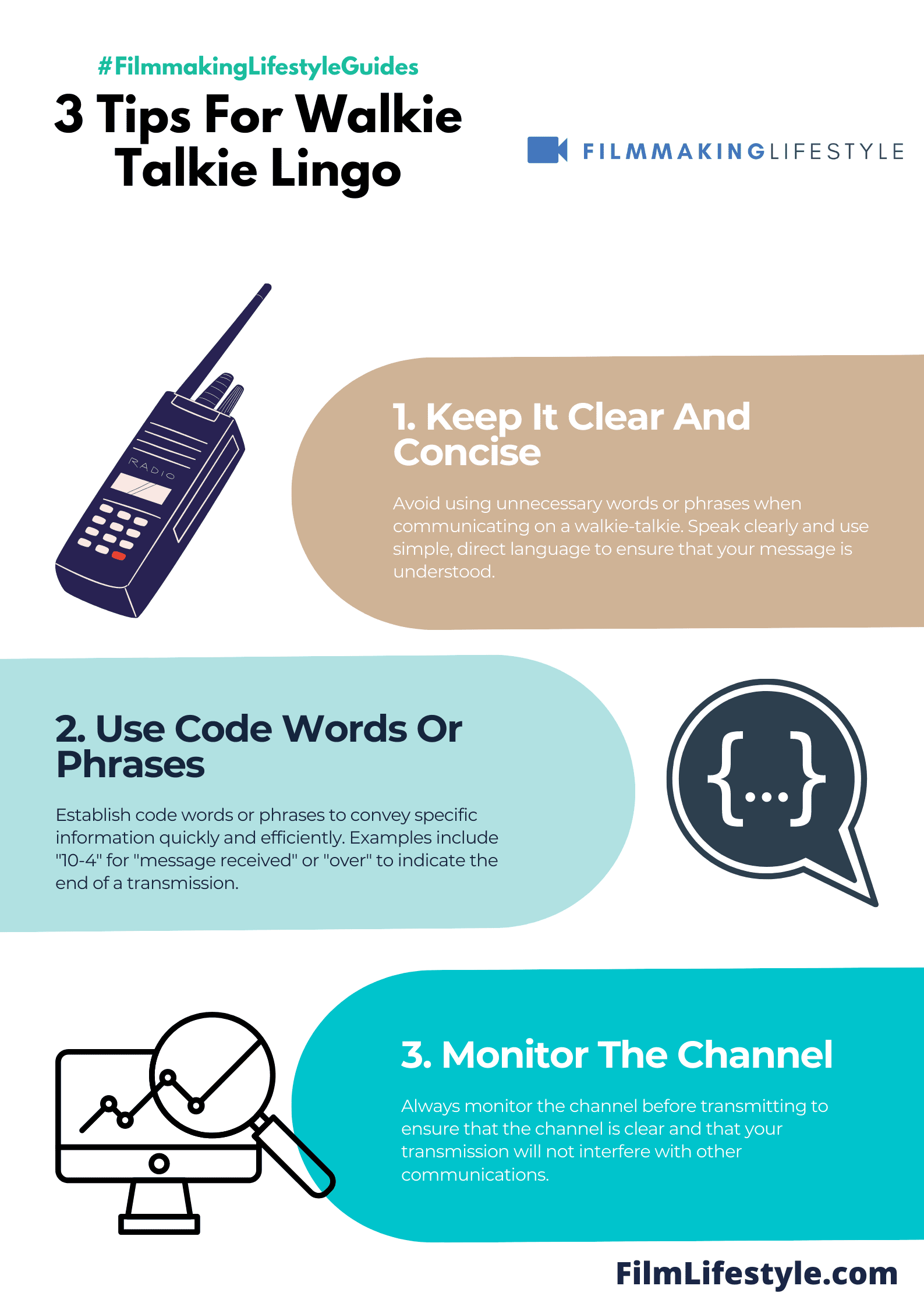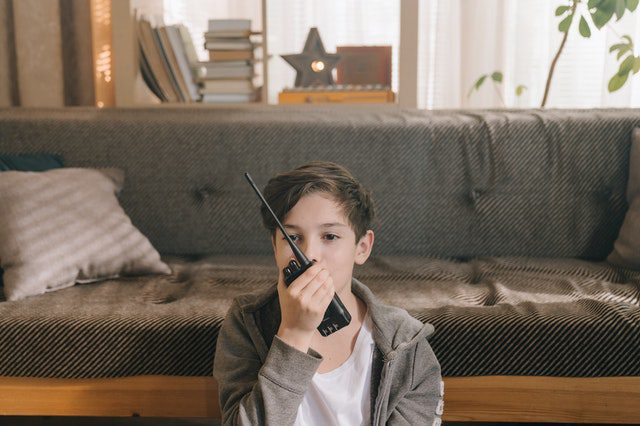If you’re a walkie-talkie user or have ever seen one in use, then there’s a good chance that you’ve heard the lingo.
If not, well, we’re here to help!
Below are some common and not-so-common terms for your reference.
Some of these are pretty inventive (like “splash” for when someone falls into the water!) but others are just too funny to be true.
Did you know that walkie-talkies have their own lingo?
If you’re a newbie who’s just getting into the hobby, it can be tough to understand what people are talking about.
Fortunately for you, we’ve compiled a list of common terms and phrases that will help get you up to speed on some of the basic walkie talkie lingo.
This article will give you the basics of what you need to know about this type of communication so you can get up to speed on what your friends might be saying when they’re out in public or just chatting over the airwaves!
WALKIE TALKIE LINGO
What Is Walkie Talkie Lingo?
Walkie Talkies are used on film sets to communicate in a soundproof environment.
This is because they have the ability to make sure that only one person can hear what’s being communicated, and it can be done without anyone else hearing.
They’re also used for safety purposes so people don’t get too close to each other when they’re filming dangerous scenes or stunts.
Ever tuned into a conversation between professionals using walkie-talkies and felt like they’re speaking a whole different language?
Well, they are!
Walkie talkie lingo is a mix of codes, shorthand, and jargon that keeps communication clear and concise in critical situations.
In this complete guide, we’ll decode the static and break down the essential phrases, terms, and protocols that make up the unique language of walkie-talkies.
Whether you’re gearing up for a tactical game, starting a new job that requires radio communication, or just curious about this verbal shorthand, we’ve got you covered.
Get ready to transform your static-filled transmissions into clear-cut messages.
After diving into our guide, you’ll be calling “10-4” like a pro and navigating the airwaves with confidence.
What Is Walkie Talkie Lingo?
Walkie talkie lingo is the specialized language that’s become indispensable for efficient and effective communication over two-way radios.
It consists of short, precise phrases and a set of codes designed to convey messages quickly and without ambiguity.
This specialized vocabulary is crucial when every second counts, which is often the case in emergency situations or fast-paced working environments.
Our aim is to demystify this jargon, helping you to understand and use it with confidence.
The lexicon has its roots in military practice, but has since been adopted by a wide range of professionals.
Law enforcement, film crews, event coordinators, and many more rely on this form of communication.
At its core, walkie talkie lingo helps ensure everyone on the channel stays on the same page.
There are no lapses in communication which might otherwise lead to mistakes or misunderstandings.
Our guide dives into the common phrases used in walkie talkie communication:
- Understanding terms such as “Roger” – signifying acknowledgement,
- Figuring out what “Over” – indicates the end of a transmission,
- Knowing when to use “Mayday” – the term for a distress call.
also, we take a look at the phonetic alphabet.
This is a critical component of walkie talkie speech, used to spell out certain words to avoid confusion.
Think of every letter having its unique word equivalent: Alpha for A, Bravo for B, and so forth.
This system is especially useful in noisy or chaotic environments where letters like ‘D’ and ‘T’ might be easily mistaken for one another.
Remember, mastery of walkie talkie lingo isn’t just about knowing the terms.
It’s about ensuring clear, concise, and swift communication that could, in some instances, save time or even lives.
Importance Of Walkie Talkie Lingo
Walkie talkie lingo is more than just a series of codes and phrases; it’s a streamlined language that ensures messages are conveyed efficiently.
With a set lexicon, we reduce misunderstandings and foster a secure environment for communication.
In high-stakes scenarios, like coordinating stunts in Fast and Furious or managing crowds at live events, precision is critical.
The lingo allows us to relay complex instructions swiftly, minimizing the margin for error.
Clear communication also preserves the integrity of the film set.
It helps maintain the flow of production and keeps everyone from the director to the grip in sync.
Short, clear instructions through walkie talkie lingo can make the difference between a shot that’s executed perfectly and one that needs costly retakes.
Proficiency in this specialized language enhances safety.
Consider the emergencies on a set – a quick and clear ‘Mayday’ or ‘Code Red’ can save lives and equipment.
Here’s what effective walkie talkie communication achieves for us in filmmaking:
- Streamlines on-set workflow – Increases safety during production – Saves time and reduces the need for repetitive takes – Improves coordination between different departments.
We adapt our communication to the unique needs of each production.
Whether we’re filming in a serene studio or amidst the chaos of an outdoor festival, our command over walkie talkie lingo is what keeps every member of the team aligned and aware.
Common Walkie Talkie Codes And Phrases
Navigating the set of a film like The Matrix requires efficient communication.
That’s where our mastery of walkie talkie lingo comes into sharp focus.
Teams behind the scenes depend on a shared language to get the job done.
Miscommunications can lead to costly delays or even accidents.
Knowing the exact phrases to convey complex instructions quickly is vital.
And it all starts with some fundamentals.
Understanding Basic Walkie Talkie Codes
Let’s jump into the ABCs of walkie talkie speak.
The basics are pretty straightforward:
- 10-1: Receiving poorly,
- 10-2: Receiving well,
- 10-4: Message received and understood,
- Affirmative: Yes,
- Over: I’ve finished speaking,
- Roger: Your message is received and understood.
There are others, too, like “Copy That,” signifying that the message was received, or “Standby,” indicating that one should wait for further instructions.
In our industry, time is money.
So swift acknowledgment matters.
Navigating Through Noise And Distractions
On the bustling set of Transformers, communication must cut through the roar of action.
Our lexicon includes phrases tailored for clarity in these chaotic environments.
Terms like “Go for [name]” and “What’s your 20?
” – meaning, “I’m ready to talk” and “Where are you?
” respectively – keep the movements fluid.
Everyone knows where they need to be and when.
It saves us from shouting over the din or repeating ourselves.
Strategizing Complex Scene Coordination
Strategy is key when filming intricate scenes, whether they’re in Inception or Jurassic Park.
Controllers often use code names for areas on set and phrases to orchestrate movement:
- The Hot Set: The active filming location,
- Flying In: Bringing an object to set quickly,
- Eyes On: Asking if someone sees something specific.
Using these codes helps us navigate the complexities with precision.
As we continue to envelope ourselves in the film’s world, each succinct command is a thread in the tapestry of a scene well made.
Understanding Walkie Talkie Shorthand
Walkie talkie shorthand is the lingua franca of film sets.
It’s a system of abbreviated codes and phrases that enable rapid communication without the unnecessary chit-chat that can slow down production.
Our capacity to quickly interpret and respond to these signals is crucial.
It ensures we’re all on the same page, especially when filming complex sequences where timing and safety are
Some commonly used terms in the film industry include:
- 10-1 and 10-2: Bathroom breaks,
- Copy: Message understood,
- Go for [name]: Indicates you want to speak to a particular person,
- Stand by: Pause and wait for further instructions,
- Eyes on [item/person]: Requesting visual confirmation.
Mastering this shorthand isn’t just about memorizing codes.
It’s about understanding the rhythm and flow of communication that keeps our work efficient.
We prioritize clarity over chatter to avoid misinterpretation.
Clear and concise transmissions ensure that even amidst the cacophony of a film set, our messages are never lost in translation.
Consistent practice of walkie talkie shorthand on set turns the complex into routine.
It transforms our crew into a well-oiled machine, poised to tackle any challenge with deft coordination.
In Jurassic Park, this shorthand communication was critical to executing scenes with intricate animatronics.
The agility of our walkie talkie dialogue mattered as much as the nimble maneuvers of the raptors on screen.
Our expertise with walkie talkie lingo can be the difference between a smooth take and a costly delay.
It’s an art form in its own right, shaping the very fabric of our workflow.
Walkie Talkie Jargon: Terms To Know
Walkie talkies are the lifelines on a film set.
Knowing the jargon can make the difference between a seamless take and a costly miscommunication.
With various terms used to communicate quickly and discreetly, it’s imperative to get up to speed with the commonly used lingo.
Here are some key terms that every member of a film crew should know:
- 10-1: Bathroom break,
- 10-2: Signal good,
- Go for [name]: Ready to talk to the person,
- Standby: Hold on,
- Copy that: Message understood,
- Eyes on [person/item]: You have visual contact.
In action-packed scenes where stunt coordinates are involved, terms like “go hot” or “rolling” are vital for signaling the start of a critical action or take.
Precision here is not just about efficiency – it’s about safety.
When dealing with scenes involving intricate animatronics, like those in Jurassic Park, the stakes are even higher.
On a film set, speed is of the essence, and brevity in communication is key.
Short phrases like “lock it up” to signal crew members to secure the set for a take, or “fly in” when a piece of equipment needs to be brought in quickly, are invaluable.
These terms help maintain a swift workflow, eliminating any unnecessary chatter that could slow down production.
Walkie talkie lingo extends to various departments.
The art department may request a “brush-up” for a quick set touch-up, while the grips might be asked to “flag” a light, indicating to block or diffuse it.
Every department has its specific set of terms, fostering an environment where each member speaks the same language, figuratively and literally.
Mastering walkie talkie language is akin to learning an essential trade language.
It’s about more than just knowing the terms – it’s about understanding the timing and context in which to use them.
As with any aspect of filmmaking, practice makes perfect, and regular use will embed these terms into your on-set vocabulary, ensuring we’re all on the same channel.
Walkie Talkie Protocols And Etiquette
Walkie talkies are the lifelines of communication on set, but they come with an unspoken rulebook.
It’s crucial that every team member knows the basics to keep the lines clear and productive.
To start, always identify yourself and the person you’re trying to reach.
This protocol prevents confusion and ensures your message is heard by the intended recipient.
Remember, brevity is key.
Be clear and concise with each transmission to avoid clogging the airwaves.
Here are some foundational points everyone should follow:
- Press the talk button and wait a beat before speaking – this ensures your first words aren’t cut off,
- Use the recipient’s department or role instead of personal names for privacy and clarity,
- Respond promptly; a quick “copy” or “go for [name/department]” acknowledges reception without delay.
Keep the channel open for important communications.
Personal conversations should take place off-air to maintain walkie talkie etiquette.
When passing off a walkie to another team member, make sure to update them on any ongoing conversations or directives.
This step keeps everyone on the same page and maintains the flow of efficiency.
Bear in mind the need to keep one’s voice even and clear, especially when the environment gets stressful.
Skullcaps can sometimes interfere with transmission clarity, so adjust your speaking volume and clarity as needed.
Finally, always perform a radio check with your team before diving into the day’s shoot.
This ensures everyone’s equipment is functioning correctly and that all members are ready to communicate effectively.
Using Walkie Talkie Lingo In Different Scenarios
Walkie talkies aren’t just for film sets—they’re vital in many high-pressure environments where clear and concise communication is
We’re about to jump into how these compact radios are essential across various fields, each with its unique set of lingo and protocols.
On Construction Sites, communication must cut through the noise of heavy machinery and bustling activity.
Here, phrases like “Copy that” for acknowledgment and “Go ahead” when ready to listen are common.
Workers use specific codes to reference safety procedures and locations on the site swiftly.
During Large Events or Conferences, walkie talkies help coordinate staff across sprawling venues.
Event managers often Carry out lingo for directing teams, securing areas, and managing schedules.
Quick codes like “10-4” for confirmation and “10-9” for repeating a message maintain the flow amidst the chaos.
For Emergency Responders, precision in communication can be life-saving.
Paramedics, firefighters, and police officers use a mix of numbered codes and standard lingo to convey situations instantly.
Terms like “code red” for a fire or “10-76” indicating en route are critical here.
We also see specific walkie talkie lingo in the world of Filmmaking where every second counts.
For example:
- “Flying in” refers to an item being brought to set quickly.
- “Lock it up” is used to secure the set for a take.
These scenarios emphasize the necessity of familiarizing oneself with the walkie talkie shorthand pertinent to their field.
Training and practice ensure that all team members are on the same wavelength, which in turn bolsters efficiency and safety.
The versatility of walkie talkies also extends to less critical, but equally planned scenarios such as Outdoor Film Shoots.
Here, the lingo adapts to include environmental factors:
- “Going hot” indicates that filming is about to Begin.
- “Eyes on” asks for visual confirmation of a person or object.
Whether it’s handling dangerous stunts, managing a crowd of extras, or coordinating the transportation of crew and equipment, walkie talkie lingo varies to fit the need.
Our understanding of these codes and their implementation directly affects the success of our collaborative efforts.
Tips For Clear And Effective Communication
Walkie talkies are essential tools on set.
Their efficacy hinges on our ability to communicate clearly and swiftly.
During a busy shoot, clarity is king.
We ensure messages are concise to avoid confusion and maintain the flow of work.
Jargon and shorthand are the lifeblood of set communication.
Familiarizing ourselves with these terms significantly improves our ability to respond with agility.
Practice is

We engage in regular drills to solidify our command over walkie talkie lingo, making it second nature.
Here are several strategies to enhance communication:
- Ensure the walkie talkie is charged and in good working condition before starting. – Speak directly into the microphone to avoid garbled transmissions.
- Use the NATO phonetic alphabet for spelling out tricky or important words. Letters like M and N or D and T can easily be mistaken for each other, especially in loud environments.
It’s vital to listen before speaking.
We avoid cutting off others and ensure the channel is clear, minimizing the risk of missed or partial messages.
Clarifying messages when in doubt can save precious time.
We repeat critical information back to the sender to confirm our understanding.
Adjusting walkie talkie settings to suit the environment plays a crucial role.
We avoid interference and ensure optimal volume levels to keep communications crisp.
Anticipating the needs of the team allows us to preempt requests.
We stay one step ahead, keeping our interactions proactive instead of reactive.
Walkie Talkie Lingo The Complete Guide – Wrap Up
We’ve equipped you with the essentials of walkie talkie lingo, a tool that’s as critical as the devices themselves on film sets and beyond.
Mastering this language means you’re ready to jump into action, ensuring that every cue and command is executed flawlessly.
Remember, clear communication is the linchpin of teamwork and when we’re all on the same frequency, there’s no limit to what we can achieve.
So keep your walkie charged and your earpiece ready—we’re counting on you to keep the lines clear and the messages concise.
Let’s make our next production not just good, but great.
Frequently Asked Questions
Why Is Walkie Talkie Lingo Important On Film Sets?
Walkie talkie lingo facilitates efficient, clear, and rapid communication, which is vital to coordinate complex tasks under time constraints while ensuring safety on film sets.
What Is Walkie Talkie Shorthand?
Walkie talkie shorthand consists of abbreviated codes and phrases designed for quick and concise communication, reducing the need for longer, potentially unclear messages.
How Does Walkie Talkie Lingo Contribute To Safety And Timing On Set?
Understanding and responding promptly to walkie talkie calls can significantly enhance safety and timing, especially during filming of complex scenes where precise coordination is essential.
Can You Give Examples Of Common Walkie Talkie Terms Used In The Film Industry?
Common terms include “10-1” for bathroom break, “copy” for acknowledged, “go again” for repeat your last message, “standby” for pause in conversation, and “what’s your 20?
” for location inquiry.
What Role Did Walkie Talkie Lingo Play In Movies Like Jurassic Park?
Walkie talkie lingo was crucial in coordinating scenes involving complex animatronics, where timing and clear instruction were key to achieving the desired on-screen effect.
What Are Some Tips For Effective Walkie Talkie Communication On Set?
To communicate effectively, be clear and concise, familiarize yourself with common jargon, practice using the equipment, and always listen before speaking to avoid interrupting conversations.
Why Is The Nato Phonetic Alphabet Used On Film Sets?
The NATO phonetic alphabet is used to spell out difficult or significant words to avoid misinterpretation due to poor reception or similar-sounding letters.
How Should Walkie Talkie Settings Be Adjusted On Set?
Settings should be adjusted to match the environment’s noise level and conditions to ensure clear transmission and reception of messages.





